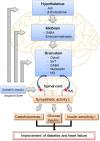Integrative care: acupuncture based neuromodulation therapy for diabetes and heart failure
- PMID: 38298910
- PMCID: PMC10827876
- DOI: 10.3389/fnins.2024.1332957
Integrative care: acupuncture based neuromodulation therapy for diabetes and heart failure
Abstract
The relationship between heart failure and diabetes is intricate and bidirectional. Individuals with diabetes face an elevated risk of developing heart failure due to factors like insulin resistance, chronic inflammation, and metabolic irregularities. Elevated blood sugar levels can harm blood vessels and nerves, culminating in the buildup of fatty deposits in arteries, atherosclerosis, and hypertension, which significantly contribute to heart failure. Furthermore, diabetes can adversely impact the structure and function of the heart muscle, impairing its pumping capacity. Conversely, heart failure can also contribute to the onset of diabetes by disrupting the body's metabolic processes and amplifying insulin resistance. The complex interaction between these conditions mandates a comprehensive approach to managing individuals with both diabetes and heart failure, underscoring the importance of addressing both aspects for enhanced patient outcomes. Although existing pharmacological treatments are limited and frequently associated with undesirable side effects, acupuncture has established itself as a traditional practice with a legacy. It remains a supplementary option for treating cardiovascular diseases. Heart failure and diabetes are both heavily associated with chronic upregulation of the sympathetic nervous system, which has been identified as a pivotal factor in the progression of disease. Mechanistic interplays such as the attenuation of central nitric oxide signaling may interfere with the production or availability of nitric oxide in key areas of the central nervous system, including the brainstem and hypothalamus. This review will delve into the current understanding of acupuncture on the autonomic nervous system and offer insights into its potential role in the future treatment landscape for diabetes and heart failure.
Keywords: acupuncture; brain stem; central nervous system; diabetes; heart failure; neuromodulation; neurotransmitters.
Copyright © 2024 Zhou, Lee, Zhou and Lombardo.
Conflict of interest statement
The authors declare that the research was conducted in the absence of any commercial or financial relationships that could be construed as a potential conflict of interest.
Figures
Similar articles
-
Cardiometabolic Risk Factors Associated With Type 2 Diabetes Mellitus: A Mechanistic Insight.Clin Med Insights Endocrinol Diabetes. 2023 Dec 25;16:11795514231220780. doi: 10.1177/11795514231220780. eCollection 2023. Clin Med Insights Endocrinol Diabetes. 2023. PMID: 38148756 Free PMC article. Review.
-
Dietary glycation compounds - implications for human health.Crit Rev Toxicol. 2024 Sep;54(8):485-617. doi: 10.1080/10408444.2024.2362985. Epub 2024 Aug 16. Crit Rev Toxicol. 2024. PMID: 39150724
-
The paraventricular nucleus and heart failure.Exp Physiol. 2014 Feb;99(2):332-9. doi: 10.1113/expphysiol.2013.072678. Epub 2013 Dec 6. Exp Physiol. 2014. PMID: 24317407 Review.
-
[Effects of acupuncture on endothelial active factors and related autonomic neurotransmitters in spontaneous hypertension rats].Zhongguo Zhen Jiu. 2024 Aug 12;44(8):931-8. doi: 10.13703/j.0255-2930.20240204-0001. Zhongguo Zhen Jiu. 2024. PMID: 39111793 Chinese.
-
The future of Cochrane Neonatal.Early Hum Dev. 2020 Nov;150:105191. doi: 10.1016/j.earlhumdev.2020.105191. Epub 2020 Sep 12. Early Hum Dev. 2020. PMID: 33036834
Cited by
-
Acupuncture and Drug Combination Therapy for Abnormal Glucose Metabolism: Exploring Synergistic Enhancement and Reduced Toxicity Mechanisms.Diabetes Metab Syndr Obes. 2024 Nov 28;17:4525-4537. doi: 10.2147/DMSO.S492626. eCollection 2024. Diabetes Metab Syndr Obes. 2024. PMID: 39624791 Free PMC article. Review.
-
Key targets of signal transduction neural mechanisms in acupuncture treatment of cardiovascular diseases: Hypothalamus and autonomic nervous system.Heliyon. 2024 Sep 20;10(19):e38197. doi: 10.1016/j.heliyon.2024.e38197. eCollection 2024 Oct 15. Heliyon. 2024. PMID: 39386880 Free PMC article. Review.
-
Research Progress of Acupuncture in Disease Management through Autonomic Nerve System Modulation.Chin J Integr Med. 2025 Jul 25. doi: 10.1007/s11655-025-4139-8. Online ahead of print. Chin J Integr Med. 2025. PMID: 40707807 Review. No abstract available.
-
Effect of acupuncture on quality of life in atrial fibrillation: study protocol for a randomised controlled trial.BMJ Open. 2024 Nov 14;14(11):e087460. doi: 10.1136/bmjopen-2024-087460. BMJ Open. 2024. PMID: 39542467 Free PMC article.
References
-
- Amundsen B. H., Helle-Valle T., Edvardsen T., Torp H., Crosby J., Lyseggen E., et al. . (2006). Noninvasive myocardial strain measurement by speckle tracking echocardiography: validation against sonomicrometry and tagged magnetic resonance imaging. J. Am. Coll. Cardiol. 47, 789–793. doi: 10.1016/j.jacc.2005.10.040 - DOI - PubMed


